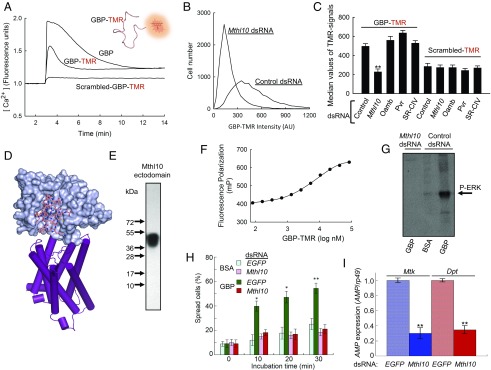Fig. 2.
Mthl10 is a cell-surface receptor for GBP. (A) Representative Ca2+-signaling dynamics in S3GCaMP3 cells upon addition of 200 nM of either GBP, GBP-TMR, or “scrambled-GBP”-TMR. (B) Representative analysis by flow cytometry of GBP-TMR association with S3 cells pretreated with either control- or Mthl10-dsRNA. (C) Analysis of the association of either GBP-TMR or scrambled-GBP-TMR with S3 cells pretreated with the indicated dsRNA (data are means ± SEM; n = 3). (D) Homology model of the extracellular domain of Mthl10 based on Mth (PDB ID code 1FJR), into which is docked GBP (which is also presented in ribbon format in the A Inset). The ribbon structure for the transmembrane domain comes from homology modeling of the β-2 adrenergic receptor (PDB ID code 3SN6). (E) SDS/PAGE of purified recombinant Mthl10 ectodomain. (F) Representative analysis by fluorescence polarization of GBP-TMR binding to the recombinant extracellular domain of Mthl10. (G) Representative Western assay of ERK phosphorylation (“P-ERK”), detected using anti-phospho-ERK1/2 antibody, following treatment of Drosophila S2 cells with either 50 nM GBP or BSA (control) for 3 min. (H) Drosophila S2 cells were pretreated with either Mthl10 dsRNA or control (EGFP) dsRNA, then 50 nM GBP or BSA control was added for the indicated times, and cell spreading was assayed (data are means ± SEM; n = 8). (I) Control- and Mthl10-dsRNA treated S2 cells were incubated with 50 nM GBP for 60 min and AMP expression was determined (data are means ± SEM, n = 7). As indicated, *P < 0.05, **P < 0.01, versus corresponding control.

